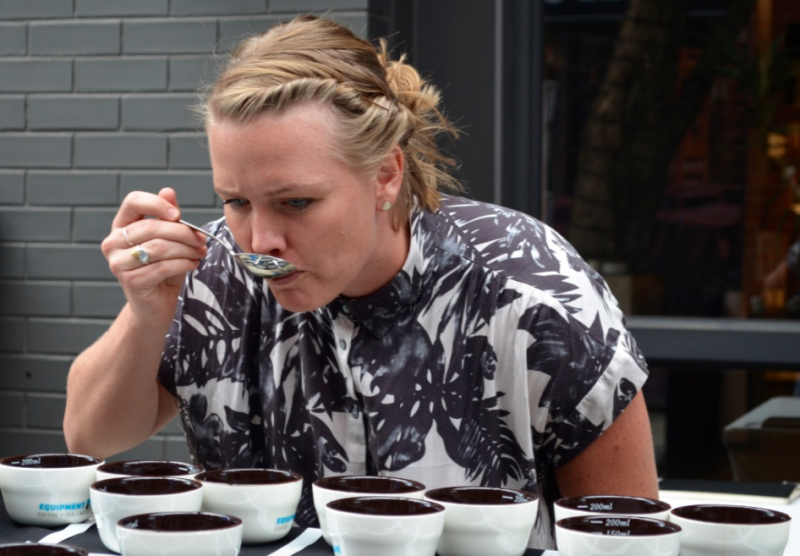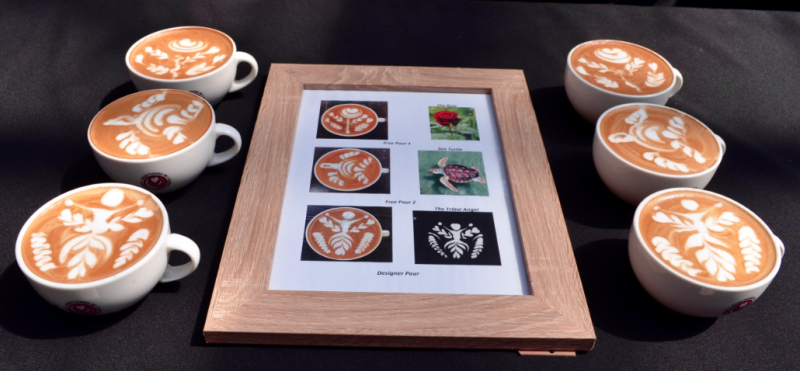The first SCASA coffee competitions in two years are happening at Hostex 26-28 June 2022.
We thought that it might be wise to give you, the consumers of coffee, the slaves to caffeine, the lovers of lattes, some insight into what the heck these competitions are all about and why you should care.
To begin with, we just want to say, we know the competitions are more than a little ridiculous, but they are a real thing, with real World Championships and real benefits for those who do well in them. So let us break it down for you.
Ok so we begin with Cup Tasters. It is pretty much what it sounds like: people tasting coffee from cups.
They are very special coffees. And they have been roasted and brewed by experts. And there are a lot of them on the table. 24 cups per person to be exact.
The competitor has 8 minutes to taste all of them. But not only that, they need to make some tough choices along the way.
The coffees are grouped in sets of three. The competitors challenge is to pick the odd one out of these three coffees. Two are the same and one is different. Find it, with your senses.
The idea is to pick the odd one out and most correct guesses out of the 8 sets wins. And in the case of a tie? The person who did it fastest wins.
As someone who has competed before, that is not as easy as it sounds. In fact, it is flipping hard. But people in the biz who taste coffees for a living; roasters, coffee quality controllers, people in the green bean importing industry, their palates are fine tuned to the slightest difference in acidity, roast and flavour in every coffee. They have to be REALLY good though, because the organisers throw in real curve balls like all three cups contain the same coffee, but one was roasted differently. (???!!!)
Why is this an important skill? Well, coffee is mostly about flavour right? And because coffee is a crop, there are lots of variables. They may be subtle to an untrained palate, but the professionals weed out any things that aren't good for your final cup. So this competition celebrates the well-trained palates out there that make sure you get the good stuff in your cup.

Maxine Thiart from Routed Roasters (JBay), representing the E Cape in the 2019 Cup Tasters National Finals.

Here the judges are seeing if the Cup tasters have correctly guessed "the odd coffee out" in the set.
Alright, alright, alright. Latte Art is probably the easiest of the disciplines to understand because it is SO pretty. But this isn't your mom's latte art. This is WILD. I'm talking lions. turtles, elephants, zebras drinking coffee, real crazy patterns made of coffee and milk.
But the patterns can't just be pretty. They're judged on contrast, symmetry, innovation and being able to replicate the pattern.
The below latte art was poured by our current SA Champion Chris Abrahams. As you can see, the competitor has to provide the judges with the imagery of the patterns they are going to attempt during his competition time.
For one of the sets they are allowed to use an etching tool, but the others are known as 'Free Pours' which means the patterns were created using only the jug and mad skills of manipulation. You get special jugs with particular spouts that can help make your pours more detailed.
All the competitors use the same coffee, the same milk and the same latte cups, but they can bring their own fancy jugs.

This is two-time SA Latte Art Champ, Chris Abrahams from Ciro beverage Solutions, Finals set from 2019.
In the world of coffee competitions, the Barista Champs are the Premier League. There's the most glory, the most prestige, the most attention from media. I think it's a fair pedestal to put the competition on, because it really is a hugely time and money consuming endeavour to participate.
The basics are that the barista has 15 minutes to produce:
4 x espresso
4 x milk beverages
4 x signature beverages
And in a cafe setting, any barista worth their salt would be able to pull off 12 drinks in well under 15 minutes, but of course this competition has nothing to do with how fast you can do it, it's all about the performance and presenting the judges with the best tasting coffees they've ever had with a unique story backing them up.
Let's take a step back.
What is a milk beverage? Ok so this round used to be called the 'Cappuccino Round' but as the trends progressed, the global community realised that coffees don't all taste that great with 150 - 180ml of milk (a classic cappuccino as defined by the old rules) so they left it to the competitor to decide. They still have to use dairy but they can use pretty much any amount of milk up to 300ml. Majority of competitors go with cortado style drinks, just a little bit of milk so as not to take too much away from that special espresso flavour but to still give it the luxurious texture of beautifully microtextured creaminess. Think Strawberry milkshakes, apricot Tropica or dark chocolate shortbread. Yum!
What is a Signature Beverage? So this is a coffee cocktail in which (sadly!) alcohol is strictly prohibited (Don't worry, they have a whole competition dedicated to that!). The keys to doing well in this course are creativity and synergy. The end beverage has to have the espresso at its core, the flavours added to the coffee have to compliment and not overpower the main ingredient. It is a very fine line to balance. Ask any competitor, it's fairly simple to make something that tastes delicious, but it's another challenge all together to make something that still tastes like or has the attributes of what you explained about your coffee. Which brings us back to the highest scoring section on the score sheet.
The Espresso Course. Why is this the most important? It looks to the spectator that it is the easiest to pull off, right? Well, that my friends, is where you would be wrong. Think about the last time you had an espresso. For some of you, maybe that's never. Why is that? We're pretty sure it's because espressos have the reputation of being bitter, sour, unpleasant or all of the above. In fact, when extracted correctly, using amazing coffee, an espresso has the potential to be sweet, bright and full bodied. A flavour experience like no other. And that, is what the competitors are trying to pull off. Not just any espresso, the best espresso the judges have ever tasted! The Espresso Course also forms the base of the rest of your drinks (99% of the time). So the flavour notes you give the judges have to be aligned with the scoresheet below. You see that is also the tricky thing. The judges can only base their scores on what the competitors tell them. So if the judges are told they will taste crisp green apple and smell jasmine and the mouthfeel will be light and sparkly, then what the barista delivers in the cup sure as s*%t better turn out that way otherwise the judges will mark them down. Basically, it is a heck of a lot of pressure in those 4 tiny cups (that can't be more than 90ml vessels).

Across all the disciplines time plays an important role. Time management is difficult when you're concentrating so hard on all the details expected of you, but as a spectator please remember that this is the competitors responsibility and they could literally get disqualified if you shout a time check to them from the crowd. Each second they go over time, they are docked a point and if the barista goes a minute over time they are disqualified, a hard lesson to learn, but it's their lesson to learn.
This video by Sprudge featuring the amazing Laila Wilbur is a fun way of getting some insight into all the things that baristas are being judged on: